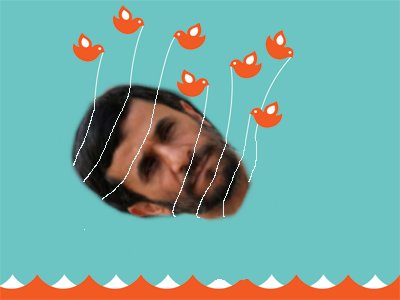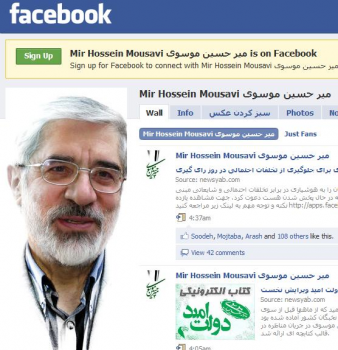Tweeting the Dialectic of Technological Determinism
Ted Friedman / Georgia State University – Atlanta

The ongoing protests in Iran over its apparently stolen Presidential election are riveting, inspiring spectacle. In particular, activists’ use of new media to organize and publicize their efforts has captivated the imaginations of the American media. With reporters’ movements inside Iran restricted, CNN and other news networks have taken to passing along YouTube videos, Facebook pages and Twitter posts directly to their viewers – most shockingly, the murder of Neda Agha Sultan, captured by cellphone video cameras.

Influential blogger Andrew Sullivan has declared the events in Iraq “The Twitter Revolution.”1 Likewise, his Atlantic colleague Marc Ambinder writes, “The Revolution Will Be Twittered.” 2 Technopundit Clay Shirky says, “it seems pretty clear that . . . this is it. This is the big one. This is the first revolution that has been catapulted onto a global stage and transformed by social media.”3

But reporters and scholars closer to the scene have expressed skepticism over the influence of Twitter and other social networking technologies in organizing the protests. Gaurava Mishra points out, “there are less than 10,000 Twitter users in Iran and less than 100 of them seem to be active. . . . [T]he on-ground organizing in Iran is probably happening via mobile phones and offline networks, the same networks that were previously used to mobilize Mousavi’s supporters to go out and vote for him.”4 Mishra concludes, “Calling the Iran protests a ‘Twitter Revolution’ is not only distracting but also dangerous because it reduces a legitimate broad-based grassroots movement to what’s quickly becoming a cliche . . .”5
Likewise, Evgeny Morozov writes, “we may be prone to embrace the thesis that the ‘Twitter revolution’ is shaking down the authoritarian fixtures of Iran simply because we know so much about the online activities of Mousavi’s supporters – and almost nothing about those of conservative hard-liners. That their voices are missing from Twitter does not mean they are not relying on the same new media tools to mobilize their own supporters; they simply do it in Farsi and on local sites – we simply do not know where to look. . . . By sticking labels like ‘cyber-revolution’ on events in Tehran, we overstate the power of social media and make it look much more threatening that it really is.”6
The American media’s enthusiasm for the new media elements of the Iran story, then, may have less to say about what’s going on in Iran than it does about the United States. The “Twitter Revolution” rhetoric fits a familiar American narrative of technological utopianism, in which hopes for social and political transformation become attached to the promise of new technologies.
But if cybertopianism offers a distorted lens for understanding the complexities of political struggles, its virtue lies in opening up the possibility to imagine new and different futures beyond the ideological constraints of conventional wisdom. This is the dynamic I describe in my book Electric Dreams: Computers and American Culture as the dialectic of technological determinism.7 On the one hand, technological determinism reifies complex social phenomena, minimizing the role of human agents by ascribing change to the impersonal, inevitable force of technological “progress.” On the other hand, the rhetoric of technological determinism opens up a utopian sphere where we can momentarily transcend immediate pragmatic concerns – since the magic of technology will take care of the “how” – and imagine a more radically different future.

A powerful recent example of the dialectic of technological determinism in action was the 2008 Presidential election. Obama’s campaign was celebrated for its new media strategy. On the one hand, claims that new media technologies produced Obama’s victory were likely overhyped. While Obama certainly used new media masterfully, he also spent more money than McCain on traditional television advertising8 and built his “ground game” around the kind of labor-intensive canvassing that political movements have employed for generations.9 On the other hand, Obama’s message of “hope” and “change” relied on persuading voters that political transformation was possible after decades of increasing cynicism. Obama’s savvy exploitation of new media technologies was a key part of convincing his supporters that they were riding the wave of the future. As infrastructure, then, new media may not have been essential to Obama’s success. But as ideology, it was crucial.

Likewise, while the “Twitter Revolution” is surely an inadequate explanation for what’s going on in Iran, it’s served a valuable purpose in inspiring Americans to become invested in the struggle, as many Twitter users “retweeted” messages directly from the streets of Iran, while others pressured news organizations to bring their full resources to bear on the story.10

The downside of the dialectic of technological determinism, however, is that risks distorting our understanding of the possible. Inspired by the cybertopians, many politicians have called for the Obama Administration to more forcefully support the Iranian dissidents. But the United States has limited influence over Iran, and as many commentators have pointed out, appearing to become too engaged in Iran’s internal affairs is likely to provoke a backlash from a population long suspicious of American actions in the region.11 In any case, many of the most vocal critics of Obama on this point are the same neoconservatives who similarly promised that the invasion of Iraq would produce an outpouring of democracy in the region. For these politicians, technological utopianism has simply replaced military utopianism as a self-serving imperial fantasy.
The task for critics of technology, then, is to distinguish cybertopian hopes from the messier reality, without giving short shrift to either. The sense of world-wide engagement with the protesters in Iran is real and inspiring, and points to the utopian possibility of a true global village of democratized discourse. But cool web tools alone will not be enough to achieve that goal, however the events in Iran play out.
Image Credits:
1. Iranian Fail Whale: Illustration by Twitter user Iridium24
2. Widely Shared Video of Neda Agha Sultan
3. Mousavi’s Facebook Page
4. The Star Trek Future, Brought To You By Replicator Technology
5. Obama’s Technological Optimism
6. CNNFail: Image Created by Blogger Olliver Willis
Please feel free to comment.
- Andrew Sullivan, “The Twitter Revolution,” The Daily Dish, June 19, 2009, http://andrewsullivan.theatlantic.com/the_daily_dish/2009/06/the-twitter-revolution.html [↩]
- Marc Ambinder, “The Revolution Will Be Twittered,” Washington with Marc Ambinder, June 15, 2009, http://politics.theatlantic.com/2009/06/its_too_easy_to_call.php [↩]
- Clay Shirky, quoted in Chris Anderson, “Q&A with Clay Shirky on Twitter and Iran,” TEDBlog, June 16, 2009, http://www.scope.nottingham.ac.uk/article.php?issue=14&id=1138 [↩]
- Gaurava Mishra, “Updated: The Irony of Iran’s ‘Twitter Revolution,'” Gauravnomics Blog, June 17, 2009, http://www.gauravonomics.com/blog/the-irony-of-irans-twitter-revolution/. As the sources of the statistic on Iraqui Twitter users, Mishra cites Alex Cheng and Mark Evans, “Inside Twitter,” Sysmos Resource Library, June 2009, http://www.sysomos.com/insidetwitter/, and Joel Schectman, “Iran’s Twitter Revolution? Maybe Not Yet,” Business Week, June 17, 2009, http://www.businessweek.com/technology/content/jun2009/tc20090617_803990.htm?chan=top+news_top+news+index+-+temp_news+%2B+analysis [↩]
- Mishra [↩]
- Evgeny Morozov, “The Repercussions of a ‘Twitter Revolution,’ The Boston Globe, June 20, 2009, http://www.boston.com/bostonglobe/editorial_opinion/oped/articles/2009/06/20/the_repercussions_of_a_twitter_revolution/?page=2 [↩]
- Ted Friedman, Electric Dreams: Computers and American Culture (New York: New York University Press, 2005) [↩]
- Michael Luo and Mike McIntire, “With Ambitious Campaign, Obama Is Both Big Spender and Penny Pincher,” New York Times, October 30, 2008, http://www.nytimes.com/2008/10/31/us/politics/31spend.html [↩]
- See Tim Dickinson, “The Machinery of Hope,” Rolling Stone, March 20, 2008, http://www.rollingstone.com/news/coverstory/19106326 [↩]
- See #CNNfail & The Social WEdia Revolution, http://cnnfail.com/ [↩]
- See, for example, Juan Cole, “Washington and the Iran Protests: Would They Be Allowed in the US?” Informed Comment, June 24, 2009, http://www.juancole.com/2009/06/washington-and-iran-protests-would-they.html [↩]
Ted,
This is by far one of the most sober takes on the role that technology, particularly Twitter, has played in the actual protests within Iran. Though the official story of the twitter-led-revolution has obviously been distorted, I feel like part of the hoopla around the event seems to involve the new speed that we are able to gain access and the new immediacy that political information is disseminated, something that you highlight in your article.
Having said all that, in the West, it’s hard not to get caught up in all that, particularly with the urgency (and, I would add, panic) that our social media technology induces. My fear in this case is once we find something different to tweet about and the wave recedes, we will abandon Iran’s revolutionaries entirely in pursuit of the technology, rather than the content of the next big thing…
Thanks for the article.
Colin
A June 2009 NPR story complements this article. In reference to Twitter use in Iranian protests, Ethan Zuckerman from Harvard’s Berkman Center for Internet and Society discusses the hype Twitter has received as a tool for political change. Here’s an excerpt:
“Twitter has become the social media darling of journalists. Between its utility as an information-gathering tool and the exuberance resulting from celebrities embracing Twitter, it’s become a pop culture phenomenon that is hard for them to ignore.
“…combine that journalistic enthusiasm toward Twitter with the Iran protest story, and it’s hard to resist covering it as something momentous. But how do you reconcile this pronouncement with the fact that only a small number of protesters are actively using Twitter?”
Ted,
This should be required reading for the American news media gushing about Twitter. I wonder how much of their Twitter sentiment is driven by their own investment in it as another channel for getting their content out to the world? Be declaring it a revolution, does it not drive those on the fence to Twitter? Look the world is undergoing a revolution right before our eyes!
Great column, Ted. I’ve found myself by turns inspired and ambivalent as a result of both the events in Iran and the discourse surrounding Twitter and its role in those events. In part, I think it does give a needed nuance to the ‘image’ of Twitter — which those outside of the media studies/early adopter community still think of as “telling people what I had for breakfast.” On the other hand. you’re absolutely right when you claim that the excitement over it says much more about American than it does about Iran and the actual forces at work in terms of social (offline) networking. Part of me thinks that Americans were looking for a new ‘righteous cause’ now that the election is over and Obama has to do ‘boring stuff’ like push healthcare through congress. Turning your avatar green is something that Obamafiles can get behind!
I think it’s interesting and important to make the distinction between a “Twitter Revolution” and the use of new media in social movements. It reminds me of the celebratory tones of folks like Howard Rheingold and Charles Tilly writing in the early 2000s about the use of mobile technology in revolutionary movements in places like the Phillipines or at WTO protests. Having been a sociology student then and a media studies now it’s also interesting to see how the two approach new media and social movements differently.
Pingback: The Chutry Experiment » Tuesday Links
Pingback: Centaur Consciousness – Mythological Narratives and 21st Century Cultural Critique, a continuing conversation with Dr. Ted Friedman, Georgia State University | [ open myth source ]
Méga passionnant! Réellement innovant au demeurant. merci pour le partage.